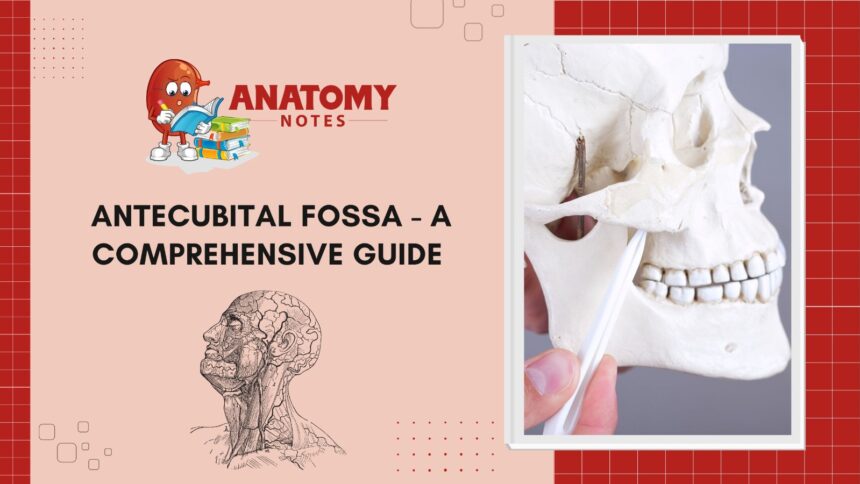Introduction to the Antecubital Fossa
Welcome to the fascinating world of anatomy, where we delve into the intricacies of the human body! Today, we’re shining a spotlight on a hidden gem – the Antecubital Fossa. This underrated area plays a crucial role in our daily activities and medical procedures. Join us on this journey as we uncover everything you need to know about the Antecubital Fossa, from its location to its clinical significance. Let’s dive in!
Anatomical Location of the Antecubital Fossa
The anatomical location of the antecubital fossa is a key area on the human body, situated in front of the elbow joint. It’s an easily identifiable region that plays a crucial role in various medical procedures and assessments. Located at the junction of the upper arm and forearm, this concave space is known for its accessibility to major blood vessels and nerves.
When you bend your arm, you can feel the antecubital fossa as a small indentation on the inner side of your elbow. This area serves as a common site for venipuncture or drawing blood samples due to its proximity to large veins like the median cubital vein. Additionally, it houses important structures such as the brachial artery and median nerve.
Understanding the precise location of this anatomical landmark is essential for healthcare professionals performing tasks like intravenous catheter placement or blood pressure measurements. Its strategic position allows for efficient access while minimizing patient discomfort during medical interventions.
Borders and Boundaries of the Antecubital Fossa
The Antecubital Fossa is a triangular depression located on the anterior aspect of the elbow joint. It’s like a hidden gem nestled between the upper and lower arm, waiting to be explored.
This fascinating area has defined borders that mark its territory with precision. The superior border is formed by an imaginary line connecting the medial and lateral epicondyles of the humerus, while the inferior boundary is created by the brachioradialis muscle.
On either side, we have our trusty friends – the pronator teres medially and brachioradialis laterally – acting as loyal guards protecting this precious space. Together, they create a safe haven for vital structures such as nerves and blood vessels to pass through unharmed.
Understanding these boundaries not only helps in anatomical studies but also provides crucial insight for medical professionals during procedures involving this region. So next time you look at your elbow, remember there’s more to it than meets the eye!
Structures Contained within the Antecubital Fossa
Within the antecubital fossa, there are vital structures that play crucial roles in arm functionality. The most prominent of these is the brachial artery, responsible for supplying oxygenated blood to the forearm and hand. Running alongside it is the median nerve, essential for motor functions and sensation in the hand.
Moreover, nestled within this region lies the biceps brachii tendon, connecting the powerful bicep muscle to the radius bone. Adjacent to it is also the radial nerve, facilitating movement and sensory information transmission throughout the arm.
Additionally, housed within this compact space is a network of veins collectively known as the median cubital vein—a common site for venipuncture due to its accessibility and prominence.
Understanding these intricate structures within the antecubital fossa provides insight into its functional significance in everyday activities and medical procedures.
Muscles Surrounding the Antecubital Fossa
The muscles surrounding the antecubital fossa play a crucial role in the movement of the elbow joint. These muscles are responsible for flexing and extending the forearm, allowing us to perform everyday activities like bending our arm or reaching for objects. One key muscle in this area is the biceps brachii, which is located on the front side of the upper arm and aids in flexing the elbow.
Another important muscle is the brachialis, situated beneath the biceps brachii and also assisting in elbow flexion. On the back side of the arm lies the triceps brachii muscle, which works to extend (straighten) the elbow joint when activated. Together, these muscles create a balanced system that enables smooth and controlled movement of our arms.
Understanding how these muscles function around this anatomical region can provide valuable insight into diagnosing and treating conditions affecting this area. Whether it’s through physical therapy exercises or surgical interventions, maintaining optimal muscle health in this region is essential for overall arm functionality.
Clinical Importance of the Antecubital Fossa
Understanding the clinical importance of the antecubital fossa is crucial for medical professionals and patients alike. This small indentation in the arm plays a significant role in various diagnostic procedures, such as blood draws and intravenous therapy. Clinicians often rely on this area for quick and easy access to veins, making it a vital site for medical interventions.
The antecubital fossa also serves as a common location for administering medications, fluids, or collecting blood samples during routine medical exams or emergency situations. Its accessibility and proximity to major blood vessels make it an ideal choice for these procedures. Additionally, healthcare providers frequently examine this area to assess overall vascular health and detect any potential issues early on.
Recognizing the clinical significance of the antecubital fossa can lead to more efficient healthcare delivery and better patient outcomes.
Common Pathologies Associated with the Antecubital Fossa
The Antecubital Fossa, while a vital area of the human body, is not immune to certain pathologies and conditions that can affect its functionality. One common issue associated with this region is the development of bursitis, which involves inflammation of the small fluid-filled sacs that cushion the joints. Another prevalent pathology seen in the Antecubital Fossa is tendonitis, where overuse or injury leads to irritation and swelling of the tendons within this space.
Additionally, nerve compression disorders like cubital tunnel syndrome can also manifest in this area, causing pain, numbness, and tingling sensations along the forearm and hand. Skin infections such as cellulitis may arise due to breaks in the skin barrier or poor wound care practices around the Antecubital Fossa.
It’s essential to be aware of these potential pathologies to seek timely medical intervention and prevent further complications that could impact daily activities involving arm movement or blood draw procedures.
Diagnostic Procedures Involving the Antecubital Fossa
Diagnostic procedures involving the Antecubital Fossa play a crucial role in assessing various health conditions. One common procedure is blood drawn from veins in this area for laboratory testing. The ease of access and minimal discomfort make it a preferred site for venipuncture. Additionally, intravenous (IV) catheters are often inserted into the veins located within the Antecubital Fossa for administering medication or fluids directly into the bloodstream.
Another diagnostic procedure performed in this region is contrast-enhanced imaging studies like CT scans or angiography. By injecting contrast dye through a vein in the Antecubital Fossa, healthcare providers can visualize blood vessels and organs more clearly during these imaging tests. Ultrasound-guided procedures to evaluate structures near the Antecubital Fossa also provide valuable diagnostic information without invasive measures.
Surgical Considerations Related to the Antecubital Fossa
When it comes to surgical considerations related to the antecubital fossa, precision is key. Surgeons must navigate this small but crucial area with great care during procedures involving the elbow joint. The antecubital fossa serves as a gateway to important structures such as blood vessels and nerves that require delicate handling.
Surgeons need to be mindful of potential complications that may arise from surgeries in this region, including nerve damage or vascular injury. Proper positioning of the patient’s arm and meticulous incision planning are essential for successful outcomes. Close attention must be paid to maintaining sterility throughout the procedure to prevent infections.
Advanced imaging techniques like ultrasound can aid in visualizing structures within the antecubital fossa preoperatively, ensuring safer surgical interventions. By staying up-to-date on best practices and techniques for operating in this area, surgeons can optimize patient safety and recovery post-surgery.
Physiological Functions of the Antecubital Fossa
The Antecubital Fossa plays a crucial role in the body’s circulatory system. This area is where major blood vessels are located, making it an essential site for drawing blood or administering medication intravenously. The physiological functions of the Antecubital Fossa involve facilitating efficient blood flow to and from the forearm and hand.
When a needle is inserted into this region, healthcare professionals can easily access veins like the median cubital vein, making procedures such as blood tests or IV therapy more accessible. Additionally, nerves running through this area provide sensory and motor function to the forearm muscles and skin.
Understanding the physiological functions of the Antecubital Fossa is vital for medical professionals performing various procedures involving this anatomical location.
Educational Models and Tools for Learning about the Antecubital Fossa
When it comes to learning about the antecubital fossa, educational models and tools play a crucial role in understanding this anatomical structure. Anatomical models depicting the antecubital fossa can provide a hands-on experience for students to visualize its boundaries and structures. Virtual reality simulations offer an immersive way to explore the depths of the antecubital fossa in a dynamic and interactive manner.
Online resources such as 3D interactive diagrams and educational websites can supplement traditional learning methods by offering detailed information on the functions and clinical significance of this region. Additionally, textbooks with comprehensive illustrations can aid in grasping the complexities of the muscles and structures surrounding the antecubital fossa.
Workshops or seminars conducted by healthcare professionals allow students to enhance their practical knowledge through demonstrations and case studies related to diagnostic procedures involving this area. By utilizing a variety of educational models and tools, individuals can gain a deeper understanding of the antecubital fossa’s importance within healthcare practices.
Conclusion
As we wrap up this journey through the intricacies of the antecubital fossa, it’s clear that this small but vital area of the body holds significant importance. From its anatomical location to the structures contained within, there is much to discover and appreciate about this region.
Exploring the borders and boundaries of the antecubital fossa gives us a deeper understanding of its structure and function, while learning about the muscles surrounding it sheds light on its dynamic nature.
Considering its clinical significance, being aware of common pathologies associated with the antecubital fossa is crucial for medical professionals and patients alike. Diagnostic procedures involving this area play a key role in identifying potential issues early on.
Surgical considerations related to the antecubital fossa highlight the precision required when operating in such a delicate space. Understanding its physiological functions helps us grasp how integral it is to everyday movement and activities.
Educational models and tools provide valuable resources for those looking to learn more about this fascinating part of human anatomy. The antecubital fossa truly exemplifies both complexity and simplicity intertwined in our bodies’ design, showcasing nature’s remarkable efficiency in even the smallest details.
Frequently Asked Questions (FAQs)
Q1. What is the antecubital fossa used for?
The antecubital fossa is commonly used for drawing blood, inserting intravenous lines, and performing various medical procedures due to its accessibility.
Q2. Can the antecubital fossa be injured easily?
Yes, the antecubital fossa can be prone to injuries such as nerve damage, fractures, and dislocations if not handled carefully.
Q3. Are there any exercises to strengthen the muscles surrounding the antecubital fossa?
Yes, exercises like bicep curls and tricep extensions can help strengthen the muscles in that area.
Q4. How can I learn more about anatomical structures like the antecubital fossa?
Utilizing educational models and tools specifically designed for learning anatomy can enhance your understanding of complex structures like the antecubital fossa.
By exploring these frequently asked questions, you can deepen your knowledge and appreciation of this essential anatomical region. Remember to handle it with care and understand its significance in various medical procedures.




